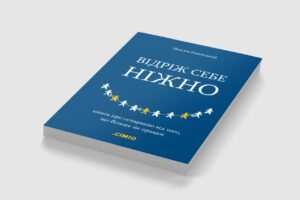
In his new book, “Cut Yourself Off Gently,” Ukrainian business coach and psychologist Maxim Romensky explores psychological separation as an important element of freedom and maturity. The author also shows how to break free from restrictive systems in order to build a life according to your own rules and scenarios. The book is the first project of the new Ukrainian non-fiction publishing house SIMIO.
At the heart of the book is the idea of ecological separation. It is about the conscious decision to let go of relationships, roles, or systems that no longer work for a person. The author analyzes dilemmas familiar to everyone: from distancing oneself from family and breaking up with loved ones to moving to another country.
Unlike Romensky’s previous books on business topics, this publication addresses everyday experiences. The book is based on real stories from clients, therapy sessions, and practical techniques that the author has been using for over 30 years. In addition, it includes questions for self-reflection, exercises, and specific phrases to help you get through separation in a constructive way.
“This book is about separation. Yes, today it has become commonplace, but it is still painful. It’s about separation from parents, friends, partners, or even adult children. And, ultimately, about parting with your own illusions. It is an experience that cannot be avoided. I want it to be not a full stop in loss, but a staircase that can be climbed from despair to clarity. And it became a reminder for all of us that there is always a way out — from any system or situation,” says Maksym Romenskyi.
The publication will be useful and supportive for anyone who feels the need to escape from difficult life scenarios and relationships. It will also be useful for professionals who work with people — psychologists, psychotherapists, coaches, and HR specialists. It is a practical tool designed for both reflection and action to help readers implement important internal decisions. The book is already available on the publisher’s website. An electronic version is also planned for release in October.
Maksym Romensky is the first author of the new Ukrainian publishing house SIMIO, which specializes in applied non-fiction. With this project, the publishing house immediately declares its mission: to be a guide and a signpost for readers.
The co-founders are Oleksandra Fidkevych, who has management experience and a background in writing, and Nataliia Podob, a journalist and editor with many years of media expertise.
SIMIO will publish books on psychology, personal growth, skill development, and entrepreneurship by contemporary Ukrainian and foreign experts. These will be carefully selected publications that will help readers expand their thinking, better understand themselves and the processes around them. And most importantly, they will provide practical guidelines for proactive action.
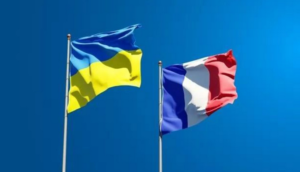
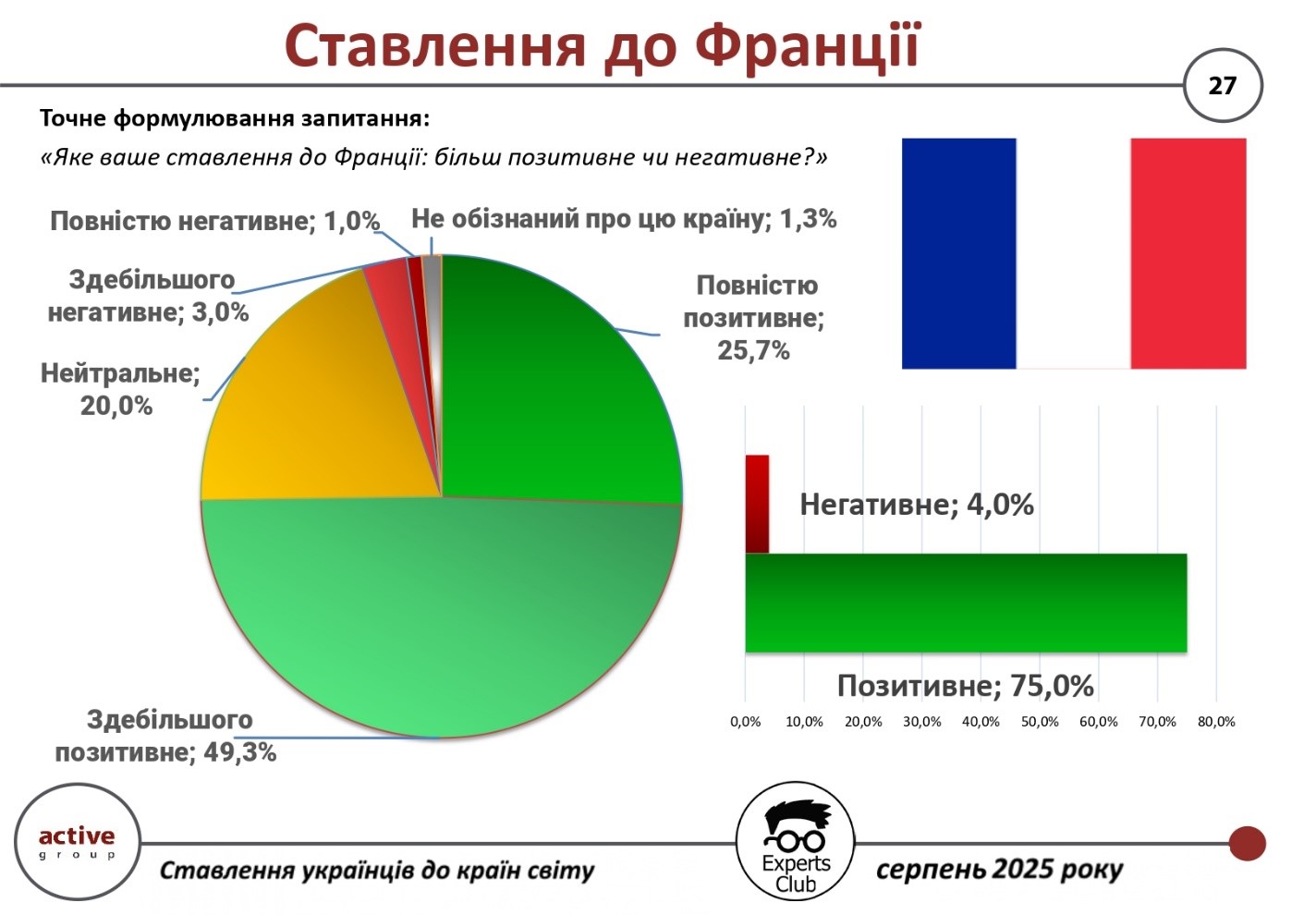
The level of sympathy for France among Ukrainians remains high. This is evidenced by the results of an all-Ukrainian sociological survey conducted by Active Group in cooperation with the Experts Club information and analytical center in August 2025.
According to the survey, 75.0% of Ukrainian citizens have a positive attitude toward France (49.3% are mostly positive, 25.7% are completely positive). Only 4.0% of respondents have a negative perception of this country (3 . 0% – mostly negative, 1.0% – completely negative). Another 20.0% remain neutral, and 1.3% said they do not have enough information about France.
“For many Ukrainians, France is a symbol of support in difficult times, as well as a cultural and political reference point in Europe. Such indicators demonstrate high trust and respect, which is largely due to the active role of Paris in European policy towards Ukraine,” said Oleksandr Poznyi, co-founder of Active Group.
In his turn, Maxim Urakin, founder of Experts Club, emphasized the importance of France in economic cooperation.
“In the first half of 2025, the trade turnover between Ukraine and France amounted to more than $1.37 billion. At the same time, exports of Ukrainian goods amounted to only $395.6 million, while imports from France reached $979.4 million. The negative balance of more than $583 million indicates a significant dependence of our market on French goods, but also the importance of France as an economic partner,” he said.
The survey is part of a broader research program that analyzes international sympathies and antipathies of Ukrainians in the current geopolitical context.
The full video can be viewed here:
https://www.youtube.com/watch?v=YgC9TPnMoMI&t
You can subscribe to the Experts Club YouTube channel here:
https://www.youtube.com/@ExpertsClub
ACTIVE GROUP, DIPLOMACY, EXPERTS CLUB, FRANCE, Poznyi, SOCIOLOGY, TRADE, URAKIN
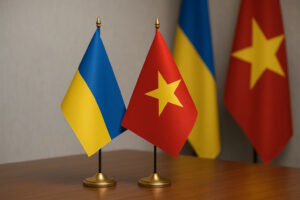
Most Ukrainians have a neutral attitude toward Vietnam, according to a survey conducted by Active Group in collaboration with Experts Club in August 2025.
According to the study, 71.3% of respondents expressed a neutral attitude toward this country. Vietnam is viewed positively by 15.7% of Ukrainians (11.3% — mostly positively, 4.3% — completely positively). At the same time, negative assessments account for 9.0% (8.0% — mostly negatively, 1.0% — completely negatively). Another 4.3% of respondents said they did not have enough information about the country.
“These results can be explained by the relatively low level of contact between Ukrainian society and Vietnam, as well as the limited number of joint cultural or political initiatives. At the same time, neutrality can become the basis for the future development of partnership relations,” commented Alexander Pozniy, head of Active Group.
In turn, Maxim Urakin, co-founder of Experts Club, drew attention to the economic aspect:
“In the first half of 2025, the total trade volume between Ukraine and Vietnam amounted to more than $560 million. At the same time, Ukraine’s exports amounted to only $104 million, while imports exceeded $455 million, resulting in a significant negative balance of $351 million. These figures clearly show that the trade balance is currently very unfavorable for Ukraine, and the range of products between the countries needs to be improved,” the expert emphasized.
The study is part of a nationwide monitoring of citizens’ attitudes toward Ukraine’s key international partners.
The full video can be viewed at:
You can subscribe to the Experts Club YouTube channel here:

The Austrian government has adopted a number of tough measures to regulate the rental housing market. Legislative innovations concern limiting rent growth and extending the minimum length of contracts, which caused a wave of discussion among tenants, property owners and analysts.
If inflation exceeds 3% per annum, landlords will not be able to fully pass on price increases to tenants. Their rent increase can only be half of the excess over the threshold. Example: if inflation is 4.2%, rent can only be increased by 3.6%.
The minimum lease term is increased from three to five years, making it more difficult to replace tenants to eliminate losses through new contracts.
An exception is made for family homes: one- and two-family properties are not affected by the new rules.
For buildings built before 1945, the rules are even tougher:
– In 2025, rents for such houses/apartments cannot be raised at all;
– in 2026, a maximum of 1%;
– in 2027 by a maximum of 2%.
In Vienna, for example, for such buildings there are already legislated maximum rents of around €6.67/m², with a number of surcharges and discounts, but often the final rent barely exceeds €10/m². Economists warn: such measures may curb rental growth, but at the same time reduce the incentive for owners to rent, potentially leading to a shortage of supply (compare with the experience of Berlin).
According to Statistics Austria and other reliable sources, as of January 1, 2025, there are about 1,855,419 people with foreign citizenship living in Austria.
The largest groups of foreign nationals are: Germany (~239,500), Romania (~155,700), Turkey (~124,000), Serbia (~123,000), Ukraine (~100,000). In 2024, the share of people with a migration background is 27.8 % of the Austrian population. This includes those born abroad and their descendants.
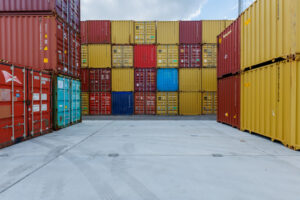
The transport and logistics group Lemtrans (Kyiv), together with Rail Trans Investment (Odesa), has completed the first phase of construction of the Fastiv container terminal, investing approximately $7 million in the first phase.
According to the company’s press release on Friday, two new railway tracks and a container yard capable of storing up to 1,350 TEU have been fully equipped as part of the project.
The company emphasizes that, in line with its growth strategy, the terminal’s throughput capacity is expected to reach 55,000 TEU.
“The completed railway infrastructure allows the terminal to accept full-length trains, which contributes to efficient loading and unloading operations,” Lemtrans emphasized.
It is noted that the terminal offers services such as a container depot and transportation organization, stowage of various categories of cargo (grain, oil, equipment, cars), as well as a customs zone and brokerage services.
In addition, its location makes it possible to organize regular container trains to Odessa and European ports, including Gdansk, Hamburg, Trieste, and others.
According to information from YouControl, Fastiv Container Terminal LLC was registered in 2020 and is owned on a parity basis by Lemtrans, Ukraine’s largest private freight operator, part of Rinat Akhmetov’s SCM Group, and Rail Trans Investment, owned by Oleksandr Prymak.
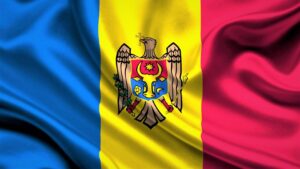
Most Ukrainians have a positive attitude toward Moldova, as evidenced by the results of a sociological study conducted by Active Group in collaboration with Experts Club in August 2025.
According to the data, 51.3% of respondents have a positive attitude towards the neighbouring country (34.0% — mostly positive, 17.3% — completely positive). Only 4.7% of respondents have a negative attitude (4.3% — mostly negative, 0.3% — completely negative). At the same time, 42.0% of citizens remain neutral, and another 2.3% said they did not have enough information about Moldova.
“Despite difficult historical relations and various political challenges, Ukrainians’ attitude towards Moldova is rather warm and friendly. This is explained by both geographical proximity and similar cultural traditions,” said Active Group CEO Oleksandr Pozniy.
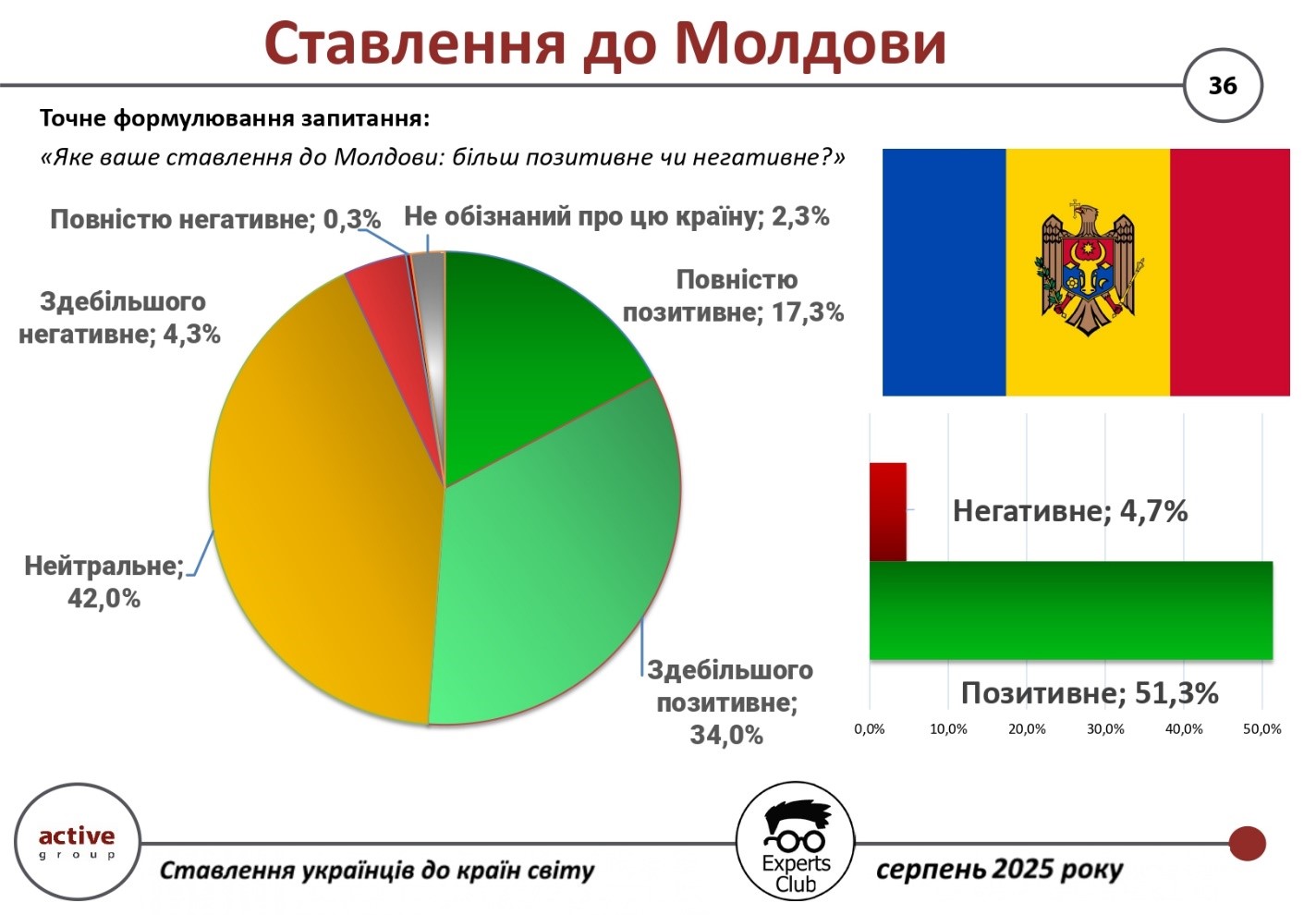
In turn, co-founder of Experts Club Maksim Urakin emphasized the importance of economic cooperation between the two countries:
“In 2025, Ukraine maintains a significant positive trade balance with Moldova — over $448 million. Ukrainian exports amounted to about $519 million, while imports — only $70.9 million. The total volume of bilateral trade reached $590 million, and this dynamic indicates Moldova’s stable interest in Ukrainian goods,” he stressed.
The study is part of a large-scale project analyzing Ukraine’s international sympathies and economic relations.
The full video can be viewed at: https://www.youtube.com/watch?v=YgC9TPnMoMI&t
You can subscribe to the Experts Club YouTube channel here: https://www.youtube.com/@ExpertsClub
ACTIVE GROUP, EXPERTS CLUB, MOLDOVA, Pozniy, RELATIONS, SOCIOLOGY, TRADE, UKRAINE, URAKIN